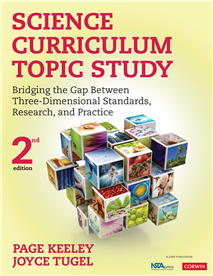The Complete Beginners Guide to Science Curriculum Topic Study
By Carole Hayward
Posted on 2019-10-02
Fans of Oprah Winfrey know the phrase, “When you know better, you do better.” And now Page Keeley and Joyce Tugel, authors of Science Curriculum Topic Study, 2nd Edition—Bridging the Gap Between Three-Dimensional Standards, Research, and Practice, are offering the perfect way for science teachers to know better and do better. In the first national workshop for Science Curriculum Topic Study, in Des Moines Iowa, on October 8, they’ll introduce participants to the new, updated Curriculum Topic Study (CTS) tools and processes for linking disciplinary content, scientific and engineering practices, and crosscutting concepts to research on learning and teacher practice.
Bring a team and learn how to use CTS as a teacher or leader.
CTS has been called the “missing link” between science standards, teacher practice, and improved student achievement. It begins with questions that help you center your teaching. For instance:
- What should students in this grade be expected to know or do about this topic?
- What common misunderstandings do students of this age group tend to have?
- What prerequisite ideas and practices am I building on?
Much of the workshop will be based on the NSTA Press book Science Curriculum Topic Study, 2nd Edition—Bridging the Gap Between Three-Dimensional Standards, Research, and Practice, which is newly mapped to the Framework for K–12 Science Education and the Next Generation Science Standards (NGSS), and updated with new standards and research-based resources. Attendees will learn to make the shifts needed to reflect current practices in curriculum, instruction, and assessment. The methodical study process used will help educators intertwine content, practices, and crosscutting concepts.
What will the Science CTS do for your school?
Why will the Science Curriculum Topic Study Workshop be a game changer for you? In the words of Nevada science teacher Gail B: “I wish I’d had this years ago! It took all the work out of looking up standards and how to apply them to students.” Just a few of the ways schools and districts change what they’re doing right away include:
- Lesson modification
- Curriculum development
- Improving articulation in science between grade levels, schools, and throughout districts
- Brushing up on background knowledge before teaching
- Identifying big ideas, concepts, practices, and important facts and terminology
- Clarifying learning goals
- Identifying developmental issues and misconceptions
- Selecting relevant phenomena
This standards- and research-based versatile process can be used by individuals or professional learning groups and supports implementation of any two- or three-dimensional standards, including the NGSS.
A follow-up web seminar, to be scheduled after the workshop, will support participants as they use CTS in their district or professional learning setting.
All participants will receive:
- Science Curriculum Topic Study, 2nd Edition—Bridging the Gap Between Three-Dimensional Standards, Research, and Practice, by Page Keeley and Joyce Tugel
- The NSTA Quick-Reference Guide to the NGSS, K–12, edited by Ted Willard
Meet the Presenters
Best-selling authors Page Keeley and Joyce Tugel will be there to guide learning, share insights, and answer questions. Page and Joyce have been science education colleagues and professional development partners for two decades, and they worked together on the original NSF-funded Curriculum Topic Study (CTS) project. As Page developed the first CTS process and authored the first edition, Joyce was instrumental in field testing and implementing the CTS professional development designs.
Your Path to Success Starts Here
- Sign up now: https://www.nsta.org/conferences/scts.aspx
- Learn to use CTS as a tool for connecting standards and research on learning to classroom practice.
- Practice building content understanding; identifying concepts, core ideas, and practices; considering implications for curriculum, instruction, and formative assessment; examining research on commonly held ideas; exploring K–12 articulation and connections; and identifying to assessment expectations.
- Apply what you learn in your school or with your district.
- Enjoy seeing your students flourish!
Disclaimer: The views expressed in this blog post are those of the author(s) and do not necessarily reflect the official position of the National Science Teaching Association (NSTA).



